Duolingo Review: Can You Become Fluent with the Popular Language Learning App?
What is Duolingo?
Duolingo is a language learning app that uses game-like methods to encourage users to keep coming back to learn every day.
- what it’s for:
- Learning simple vocabulary and sentences for a well-rounded knowledge of the target language.
- languages:
- English, Spanish, French, German, Korean, Japanese, Italian, Chinese, Arabic, Russian, Portuguese, Dutch, Turkish, Polish, Hebrew, Swedish, Hungarian, Czech, Norwegian, Irish, Esperanto, Vietnamese, Greek, Hindi, Finnish, Catalan, Swahili, Danish, Scottish Gaelic, Indonesian, Ukrainian, Latin, Romanian, Welsh, High Valyrian, Navajo, Yiddish
- level:
- Beginner - Intermediate
+ PROS
- Gamified learning keeps users motivated and on track
- Simple sentences used in target language from the start
- Visual revision reminders
- Beautiful interface
- Visual learning (with images and visual prompts)
- Duolingo Stories (in target language) and the Duolingo Podcast
- CONS
- The gamified system is potentially stressful to some users
- No control over the vocabulary topics, the order they come in, and the ability to skip them
- Pronunciation practice but no human interaction
- Some sentences would not normally be used in natural speech
- A lot of ads on the free version of the app
Can you really learn a language with Duolingo? How does Duolingo work, and how can you use the app effectively?
Here’s your quick answer: Yes, you can learn a language with Duolingo. But can you become fluent with Duolingo? Not quite.
And here’s what I’ll be sharing about in this review:
Table of contents
- How does Duolingo work?
- Duolingo Lessons
- Duolingo: What are the Lessons Like?
- Duolingo Helps You Target Your Weakest Words
- Duolingo Tracks Your Daily Progress
- Duolingo: What's Good?
- A Beautiful Interface
- A Few Cautionary Notes on Duolingo
- So Why Is Duolingo “Bad”? And Is Duolingo As Good As Rosetta Stone?
- Conclusion: Duolingo is a Great Tool for Language Learners
The language learning app Duolingo offers 37 language courses for English speakers.
The Duolingo app also includes language courses for speakers of other languages. These include French for Portuguese speakers, English for Czech speakers, Chinese for Japanese speakers, and so on. And they’re always adding more.
I've used Duolingo to learn Spanish, German and Swedish. Let's take a look at how this cool little app works and how it can support you in your language learning adventure!
By the way, if you want the tl;dr version, scroll to the bottom for my pros and cons list summarizing everything.
How does Duolingo work?
Duolingo is a great example of a straightforward language app. It's simple to use.
You set up a profile, choose your target language, set your weekly goals (only if you're brave enough), and off you go!
I've made a video in which I explain what Duolingo is, and talk about its pros and cons. You can watch it below. Otherwise, continue reading!
Here’s what Duolingo says you’ll learn during their course in Spanish:
Duolingo Lessons
Each course in Duolingo is made up of modules (the circles in the screenshot below) which are grouped to form skills.
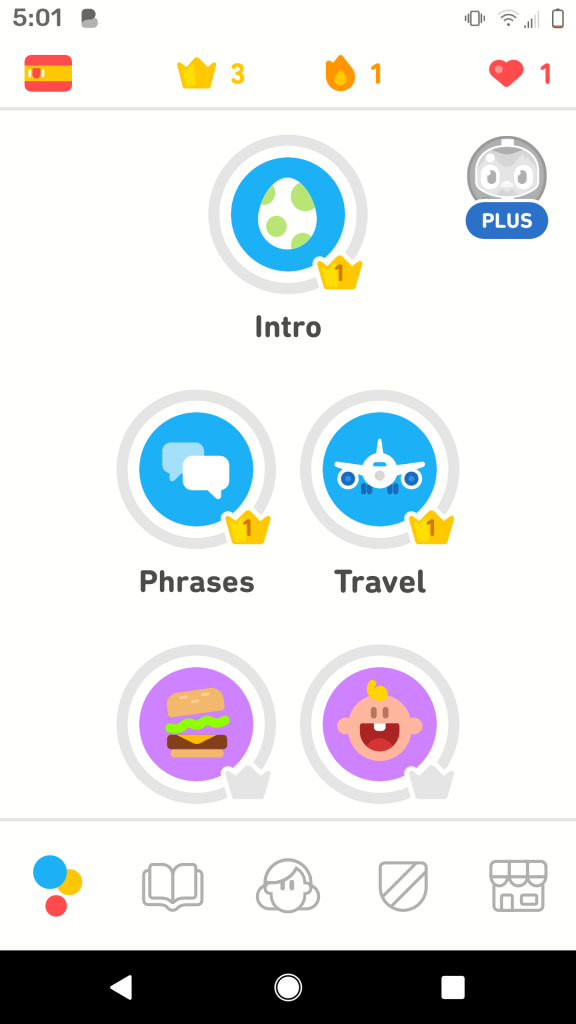
Duolingo dictates the order in which you need to complete the different modules. New modules becoming active only once you've completed the previous one. This is also the case with individual lessons within each module. You need to complete lesson 1 to be able to progress to lesson 2, and so on.
That said, Duolingo allows you to “test out of” individual modules as well as groups of modules (skills).
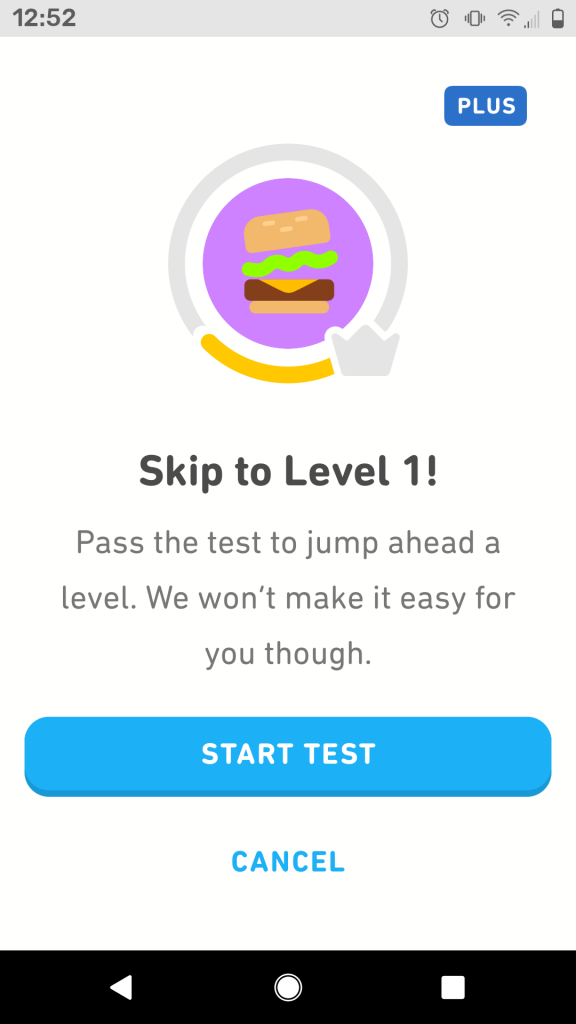
Pressing the “key” button on a category lets you take a shortcut if you want to avoid going through the individual lessons that you're already familiar with. You need to pass the test to do that, though, because there are no shortcuts in language learning!
The option to “test out” also applies when you begin a new language. You can start with the basics or you can take an entry test and let the app determine your fluency level.
Duolingo: What are the Lessons Like?
Each lesson in Duolingo is made up of a range of activities, such as translation. Here’s what Duolingo Spanish looks like for this exercise:
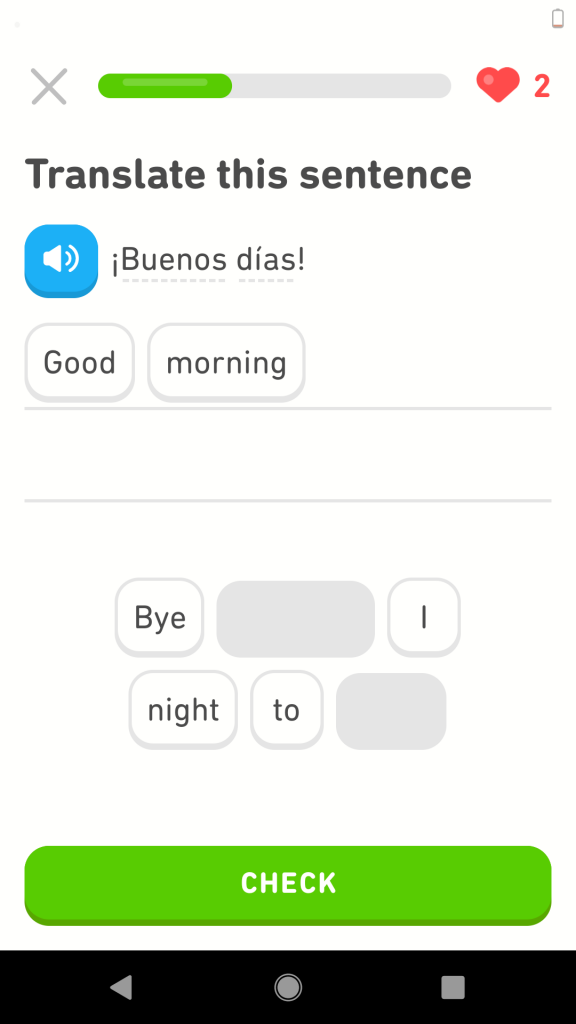
Or this activity where you have to speak into the mic what you see:
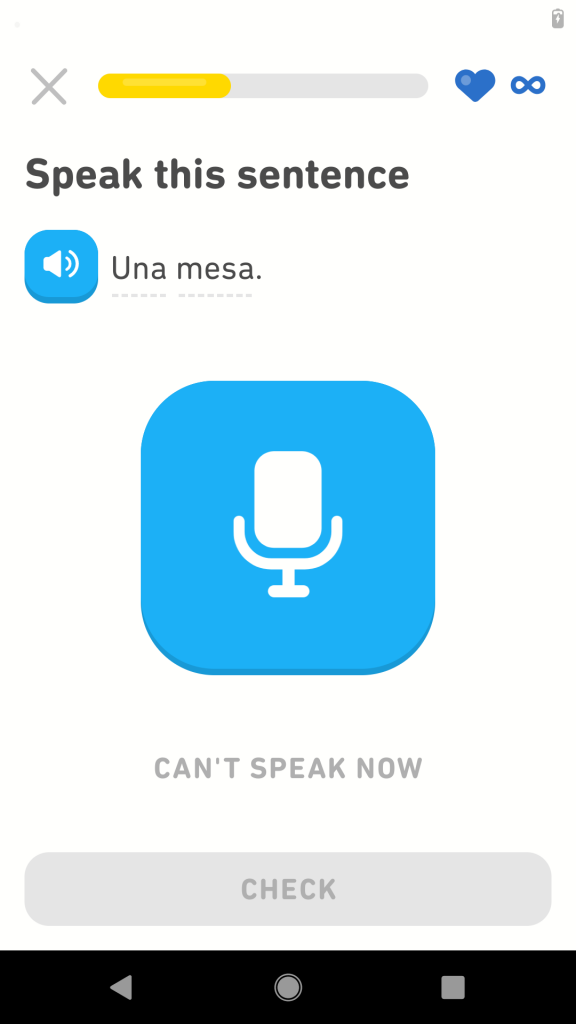
New vocabulary is often taught with images and grammar points are explained in little speech bubbles. Or, you can click on “tips” to see more grammar insights.
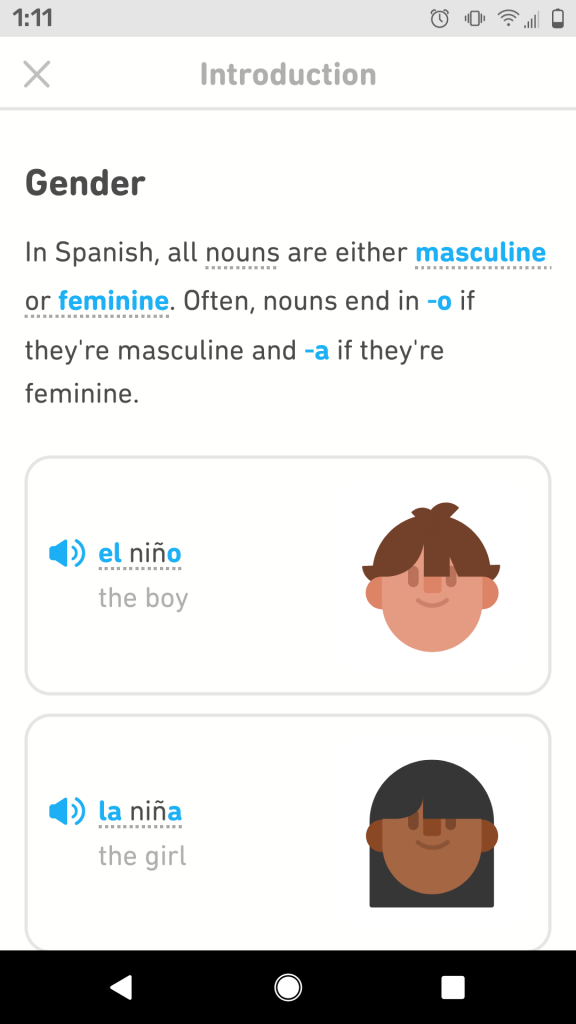
There are also listening exercises where you need to type what you hear, among others.
But if you’re not able to speak into the microphone or listen at that moment, that’s okay. The app does give you the option to deactivate your microphone or skip listening exercises for the time being.
Duolingo also uses a “hearts” system that only allows you to mess up so many times during a session. If you lose all your hearts, you have to go back and study previous material to regain hearts.
Your hearts automatically refill every day. But, if you have Duolingo Plus, you get unlimited hearts, as well as progress quizzes and some other nifty features.
Duolingo does this because their studies have shown people tend to plow through their lessons and not go back and review. So this encourages people to slow down and review to really learn.
Duolingo Helps You Target Your Weakest Words
Once you've finished the lessons in a module another screen appears. You’ll be given the option to review with either “regular practice” or “hard practice”.
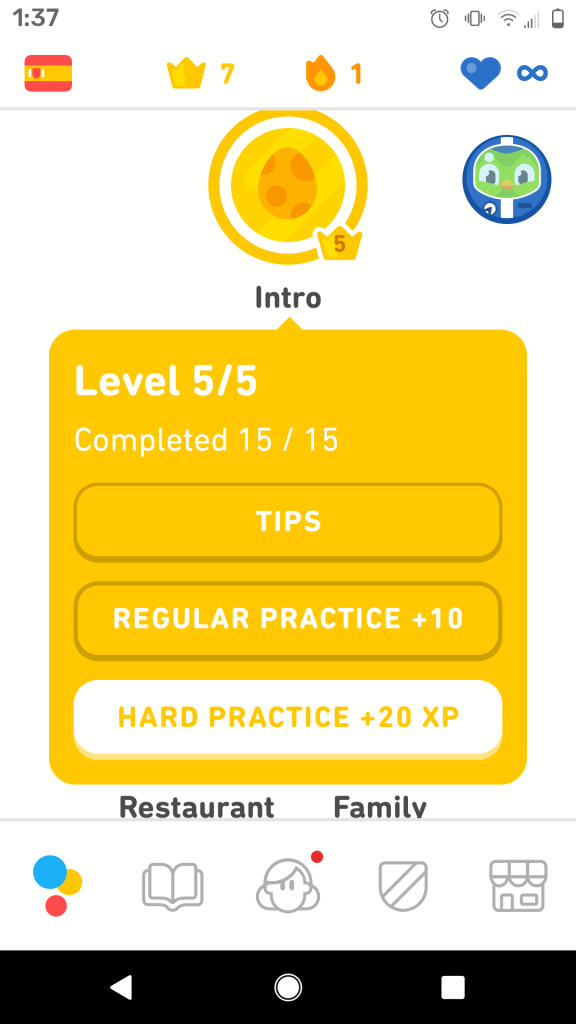
You can strengthen your weakest words there and then, or go back at a later point.
Whenever you’ve kept up with your review, your module icon will turn gold. But as the days go by, it’ll start to go back to color and have a bar showing how “remembered” it is. So keep up your review!
Duolingo Tracks Your Daily Progress
At the end of each lesson, you get a progress report that also shows your streak – the number of days in a row that you've completed. If you've earned any “lingots” (the Duolingo currency you earn as you answer questions correctly) that's also indicated on the screen.
You can use the lingots to buy different costumes for the Duolingo owl mascot, Duo, or freeze your streak if you know you’ll miss a day.
Of course, we’ve all seen the Duolingo memes with Duo and how you’ll get tons of reminders from him to keep up your streak.
Duo will show up in your notifications (repeatedly), your email, etc. You can of course turn these features off in the settings. But many users have joked how “aggressive” Duo can be, like he’s going to stalk you and make you study.
So much so, Duolingo played on the joke with a “coming soon” meme:
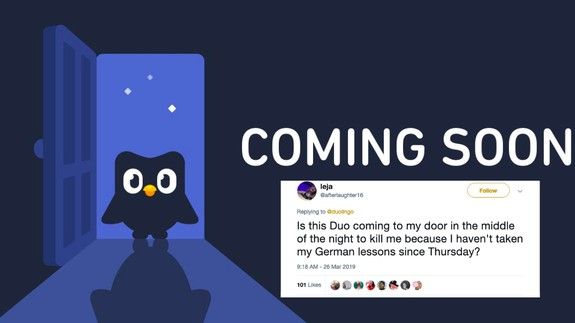
So be prepared for that.
Duolingo: What's Good?
Here are a few things that Duolingo is good at which helped me in my language learning adventures.
Help With Motivation
Duolingo recognizes language learners need to be motivated to make sure they come back to the app and engage in some more language fun. Duolingo uses several different methods to keep you hooked.
The first is its goal-setting tool.
The goals you can choose from vary from “casual” to “insane”, depending on how serious you are about learning and how quickly you want to progress.
I've picked the “regular” goal for my Spanish course and the “casual” one for German. Duo reminds you every day if you're on track to reach your goal.
This works well for those learners who are motivated by the idea of streaks and maintaining stats. It works for me. If my goal is recorded in the app, it has to happen!
And it's so nice when Duo tells me I'm on track.
Duolingo’s other two main methods are earning lingots by getting correct answers, and the leaderboard. Their leaderboard ranks you against your friends in the app or other language learnings studying your language.
Start Using Simple Sentences From Day 1
If you're an impatient language learner like me, you'll want to be able to create simple sentences straight away. Duolingo allows you to do that.
Let's look at the first lesson in the first module of the Spanish course. You start with learning some vocabulary, such as boy, apple, and water. After the first three or four slides, you'll will have learned how to say a sentence:
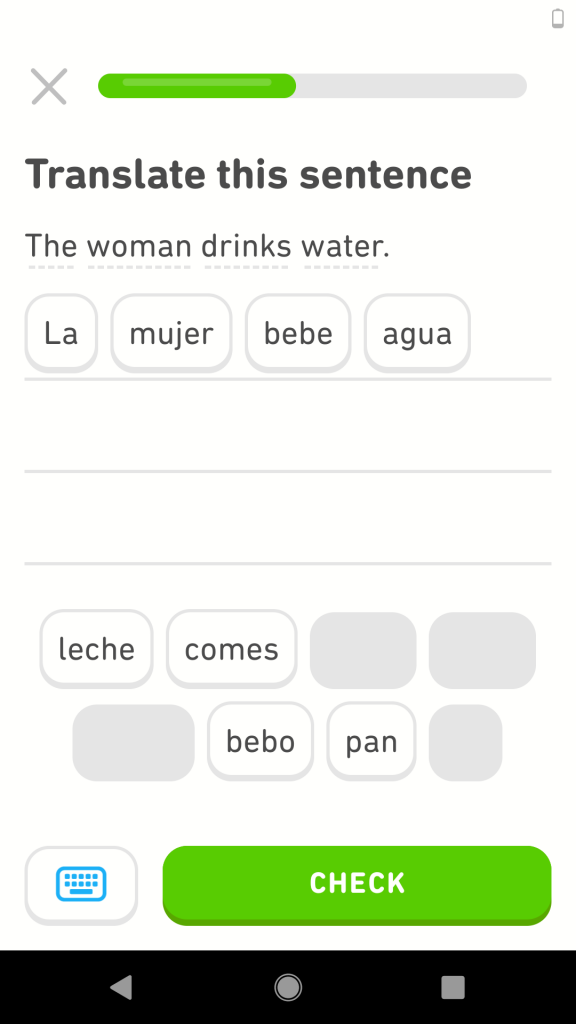
All you need to do now is go out there and start speaking to real people (rather than your smartphone screen)!
Visual Revision Reminders
The “strength” bars showing around your modules are a great reminder of the brain's imperfections. You think you've learned something and can move on but really what you need is spaced repetition to make sure the new language sticks.
Spaced repetition in language learning is a method where you revise specific words. Gradually, the intervals increase between each revision session. The theory is that, eventually, you can have an interval of several months without forgetting what something means. Duolingo makes it easy to know when your next revision session is.
A Beautiful Interface
I love everything about the sleek interface of Duolingo. One of my favourite things is the little turtle button that allows you to listen to “slow” pronunciations of the word or phrase. This creepily slow voice is a very useful feature in the exercises that ask you to type what you hear:
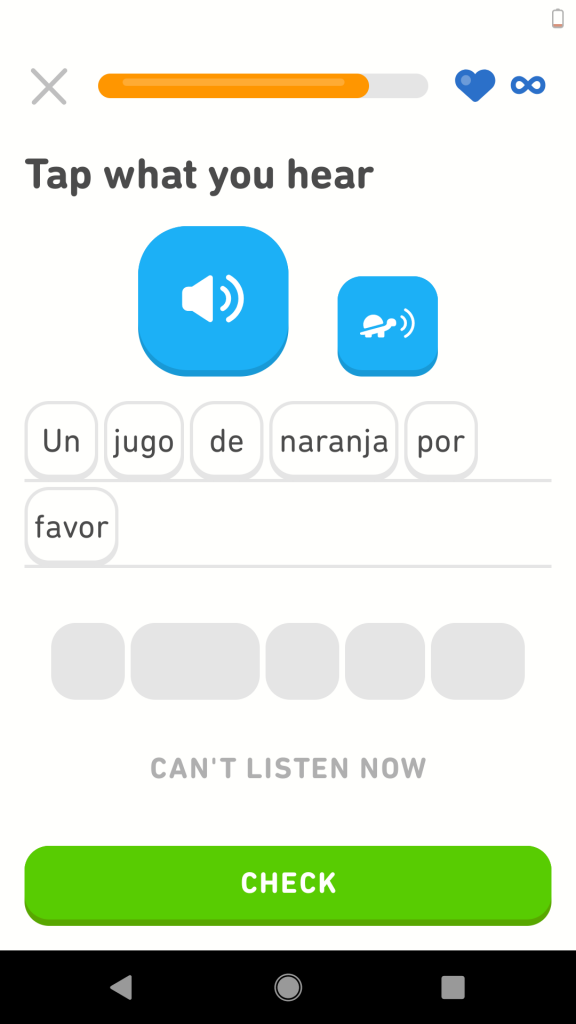
Visual Learning
A lot of the learning that goes on in Duolingo is visual. There are pictures for learning vocabulary, colours that show whether you're right or wrong. And highlighted tappable text for new words or grammar points.
If you're a visual learner like me, you'll love it.
Plus, as you continue on through the lessons, you start to learn more by context and visual cues rather than English-to-Spanish translation. This is super helpful!
Additional Learning Features: Duolingo Stories and the Duolingo Podcast
Duolingo also has the Stories feature now, where once you unlock 10 crowns (or 10 mastered topics), you get access and can start reading in your language.
This is a helpful feature to expand on your skills as you progress. It’s currently only available for Spanish, Italian, French, German, and Portuguese though.
Plus, Duolingo has a podcast for Spanish, French, and English learners. It’s essentially an audiobook to listen to stories in the language and improve on your listening comprehension. While Stories is in the app, the podcast can be listened to on Spotify, Apple, or Google.
A Few Cautionary Notes on Duolingo
Although Duolingo can be very helpful in supporting your language learning progress, there are a couple of things you should bear in mind when deciding whether the app is for you. Let me give you a brief summary of the things I noticed that could be improved.
The Hearts System Can Be Discouraging For Some
Making mistakes is an inevitable and essential part of language learning. The journey to fluency is often about having the courage to say things even if you know it's not perfect.
But with the hearts system, you can only make 5 mistakes a day. Some people may get discouraged and feel like they can’t make mistakes — even though it’s a fantastic part of learning!
But this has been improved over the years.
In the past, Duolingo used to be even tougher on mistakes. The tiniest typo or mispronunciation would cost you a heart. Now, this feature has been refined and starts to recognize typos and the like. It’ll still point them out, but it’s less harsh.
Even still, my advice to you would be: don't take Duo's perfectionism too seriously. It’s okay to make mistakes!
Some Sentences are Unnatural
This is especially true as you progress and you're learning more complex grammatical structures.
Some of the sentences that the app makes you translate would not normally be used in natural speech. Their point, though, is to illustrate certain language concepts, so it's almost forgivable.
After all, you never know when you might need to talk about milk-drinking elephants or a burger made of fish!
Not Enough Control Over Vocabulary Topics
New lessons and modules are only activated in the app once you've completed the previous lesson. So you sometimes need to learn vocabulary which is not necessarily relevant to your learning objectives.
Words for clothes and animals are not something I expect to be using at all in German but I can't continue until I've proven to Duo that I know how to say “tie” and “mouse”.
I wish I had more control over choosing which words are the ones that matter to me.
No Human Interaction
Duolingo gives you the illusion that you're practicing your speaking skills. But what the app actually asks you to do is to repeat what you can already see on the screen in written form.
So when doing Duolingo “speaking” exercises, you're essentially repeating after the app. You're not retrieving anything from memory or asking your brain to create anything from scratch.
As such, Duolingo is an app that allows you to practice pronunciation but not to speak from day 1.
That's why it's very important for language learners to supplement Duolingo with another resource. Especially one focused on speaking and interacting with other users of their target language, such as the Fluent in 3 Months Challenge.
There are a LOT of Ads if You Don’t Go With Duolingo Plus
There are so many ads in the app, including for Duolingo Plus, unless you buy Plus. This is a bit annoying and distracts from language focus.
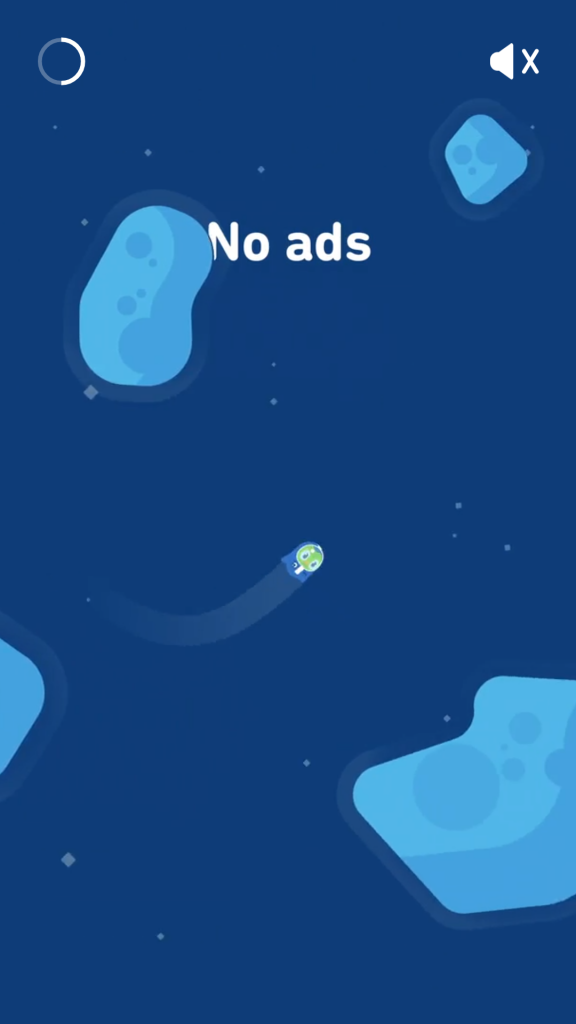
So Why Is Duolingo “Bad”? And Is Duolingo As Good As Rosetta Stone?
Duolingo has gotten some poor reviews in the past, namely because of the things I mentioned here. Especially in the past, Duolingo used to use many unnatural sentences that became memes or jokes. This has been improved on, although it’s still there.
Even so, many people became frustrated with it. Plus, many users noticed that they would study and keep their streak up for days and days, and still not be able to speak the language or could only speak at an intermediate level.
And this comes from a lack of human interaction and real speaking practice.
So, no, you can’t become fluent with Duolingo alone. But, if you pair it with other resources, it can be an amazing tool to boost your studies as a beginner to intermediate learner.
Now as far as comparing Duolingo vs Rosetta Stone? There’s no comparison. Check out Fluent in 3 Months founder Benny Lewis’ review of Rosetta Stone for the full scoop.
You’ll learn something with both of these programs. But Rosetta Stone takes a “full immersion” approach so far it becomes a flaw. Duolingo more seamlessly helps you learn in-context and wean off of English-to-Spanish translations.
So that makes it the winner here.
Conclusion: Duolingo is a Great Tool for Language Learners
Alright, to wrap this up, here’s a summary of the pros and cons of Duolingo. If you scrolled from the top for the tl;dr version, here it is.
Pros:
- Duolingo tracks your progress and weakest words
- The Duolingo app has many built-in features to boost motivation
- You learn simple sentences from day 1
- Lots of visual revision reminders so you know what needs to be reviewed
- A beautiful interface and easy-to-use “gamified” learning approach
- Lots of visual learning and learning through context
- Stories and a podcast for supplemental learning
Cons:
- The penalization for mistakes can be discouraging for some
- Some sentences are unnatural
- Not enough control over vocabulary topics to pick words relevant to you
- No human interaction or real speaking practice
- Lots of ads unless you go with Duolingo Pro
Duolingo is not a stand-alone language course, but it's an excellent addition to a language learner's toolbox. It's easy to use, it's fun and it works.
Don't forget to do the homework, though. If your aim is to achieve real fluency, remember to read, speak, and truly live the language that you're learning!
One more thing: if you are bored with Duolingo's repetitive tasks, try Clozemaster, which is Duolingo on steroids: it helps you to internalize real sentences with context.
Original review by Agnieszka Murdoch with updates by the Fluent in 3 Months team.

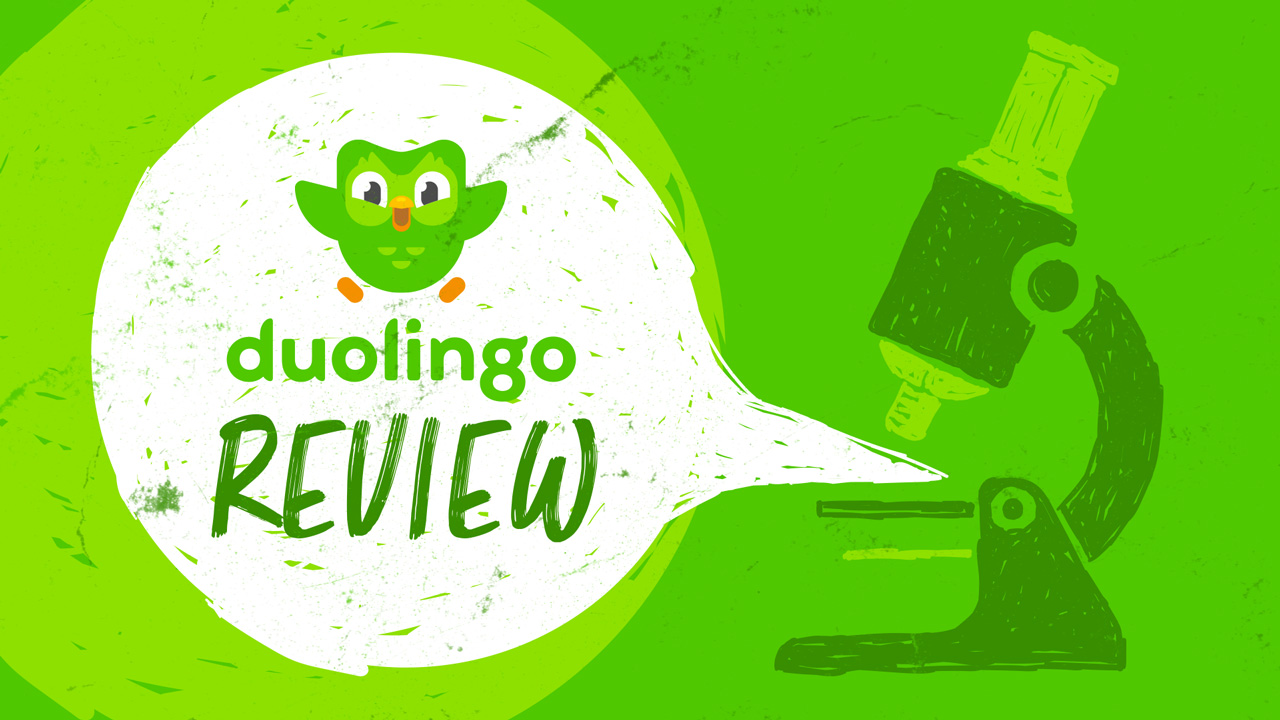

Social